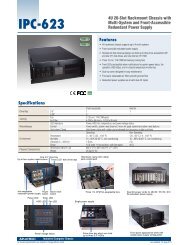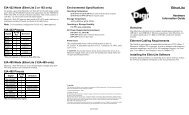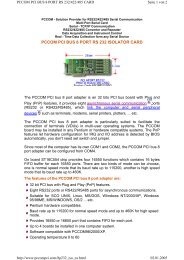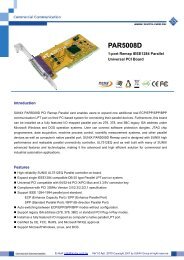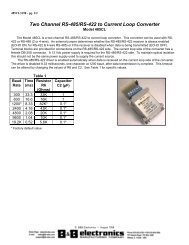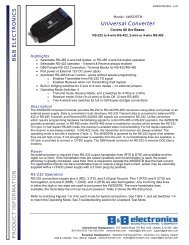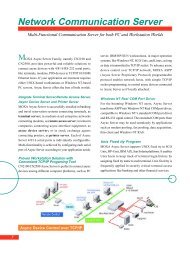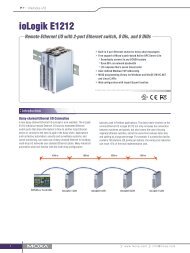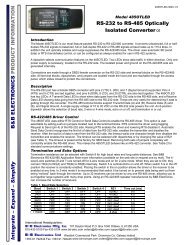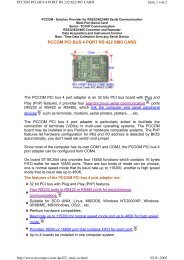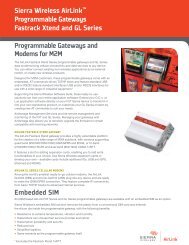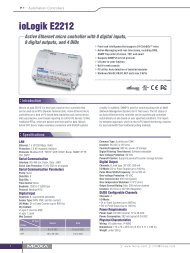Dominion KX II - CIM Guide v.8 - Raritan
Dominion KX II - CIM Guide v.8 - Raritan
Dominion KX II - CIM Guide v.8 - Raritan
You also want an ePaper? Increase the reach of your titles
YUMPU automatically turns print PDFs into web optimized ePapers that Google loves.
2. Higher Level of Remote Access – some customers would like a higher level of remote<br />
access. For example a customer might want 8 simultaneous remote users to access 16<br />
servers. So then the customer can purchase two <strong>KX</strong>2-416’s, connect each of the 16 servers to<br />
a dual <strong>CIM</strong>, and each dual <strong>CIM</strong> to both <strong>KX</strong>2-416’s.<br />
3. Connect Servers to Paragon <strong>II</strong> and <strong>KX</strong> <strong>II</strong> – in some cases, possibly while migrating from<br />
Paragon to <strong>KX</strong> <strong>II</strong>, it may be advantageous to connect a particular server to both <strong>KX</strong> <strong>II</strong> and<br />
Paragon <strong>II</strong>.<br />
Note that since these dual <strong>CIM</strong>S are Paragon <strong>II</strong> <strong>CIM</strong>s, they do not support the advanced <strong>Dominion</strong> <strong>KX</strong><br />
<strong>II</strong> features such as virtual media, absolute mouse, blade servers, smart cards and tiering. Note that<br />
both switches must be consistently set to PC-Share or Private Mode. Also note that status, availability<br />
and name changes made from one <strong>KX</strong> <strong>II</strong> switch is only known by the other <strong>KX</strong> <strong>II</strong> switch upon the first,<br />
subsequent connection made by that second switch. Contact the release Notes and User <strong>Guide</strong> for<br />
more information.<br />
• Tiering (Cascading) Feature in Release 2.3<br />
With Release 2.3 of the <strong>Dominion</strong> <strong>KX</strong> <strong>II</strong>, tiering (also known as cascading) is supported between<br />
<strong>Dominion</strong> <strong>KX</strong> <strong>II</strong> switches. A “Tiered” <strong>KX</strong> <strong>II</strong> switch can be connected via the D2<strong>CIM</strong>-DVUSB to the<br />
“Base” <strong>KX</strong> <strong>II</strong> switch. The D2<strong>CIM</strong>-DVUSB is the only <strong>CIM</strong> certified for this purpose. In addition, the<br />
“Extended Local Port” of the <strong>KX</strong>2-832 and <strong>KX</strong>2-864 can be connected to the “Base” <strong>KX</strong> <strong>II</strong> switch.<br />
For the generic hot-key based tiering, the D2<strong>CIM</strong>-DVUSB or D2<strong>CIM</strong>-VUSB <strong>CIM</strong>s can be used.<br />
• Frequently Asked Questions:<br />
1. Can I use the <strong>KX</strong> I D<strong>CIM</strong>s with <strong>KX</strong> <strong>II</strong><br />
Yes, you can. But these will not support virtual media and absolute mouse synchronization.<br />
2. Can I use the <strong>KX</strong> <strong>II</strong> D2<strong>CIM</strong>s with <strong>KX</strong> I<br />
No, the <strong>KX</strong> I was not designed to use these new <strong>CIM</strong>s.<br />
3. The server only has PS2 ports, what should I do for <strong>KX</strong> <strong>II</strong><br />
Use the D<strong>CIM</strong>-PS2. Remember the <strong>KX</strong> I D<strong>CIM</strong>s will work with <strong>KX</strong> <strong>II</strong>.<br />
4. I would like to use virtual media. What <strong>CIM</strong> do I need<br />
You need a virtual media <strong>CIM</strong>, either the D2<strong>CIM</strong>-DVUSB or D2<strong>CIM</strong>-VUSB. You also need to<br />
make sure that the target server’s (USB port, OS and BIOS) support Virtual Media. See above.<br />
5. Which virtual media <strong>CIM</strong> should I purchase<br />
If you plan to use virtual media at the BIOS level or if you plan to use Smart Cards,<br />
then you should purchase the Dual USB <strong>CIM</strong> – D2<strong>CIM</strong>-DVUSB. This <strong>CIM</strong> will support virtual<br />
media in a wider set of BIOS as well as Smart Card / CAC use. If you only plan to use virtual<br />
media at the OS level, then you can use the D2<strong>CIM</strong>-VUSB.<br />
6. When do I need to use a USB Profile<br />
Two primary uses. First, for Mac and Linux, you should use a USB profile to set the mouse<br />
synchronization mode. Second, when using the D2<strong>CIM</strong>-VUSB with some servers, you will need<br />
to use a USB Profile when in the BIOS. See the Release 2.0.10 documentation for more info.<br />
7. The customer wants absolute mouse synchronization, but not virtual media. How to<br />
handle this<br />
You can purchase the D2<strong>CIM</strong>-VUSB, but disable the virtual media permissions via the <strong>KX</strong> <strong>II</strong>’s<br />
management user interface.<br />
8. The customer wants virtual media in <strong>KX</strong> I. Can I connect the D2<strong>CIM</strong>-VUSB to a <strong>KX</strong> I<br />
No, the D2<strong>CIM</strong>-DVUSB and D2<strong>CIM</strong>-VUSB will only work with <strong>KX</strong> <strong>II</strong>. <strong>KX</strong> I switches can never<br />
support virtual media due to hardware differences.<br />
Revision: July 2010 Copyright © 2010 <strong>Raritan</strong>, Inc Page 7 of 10



